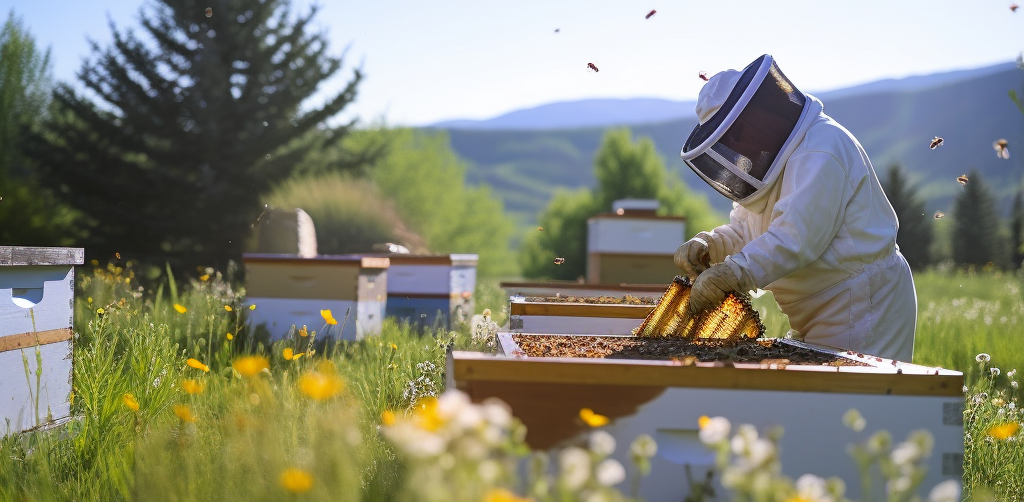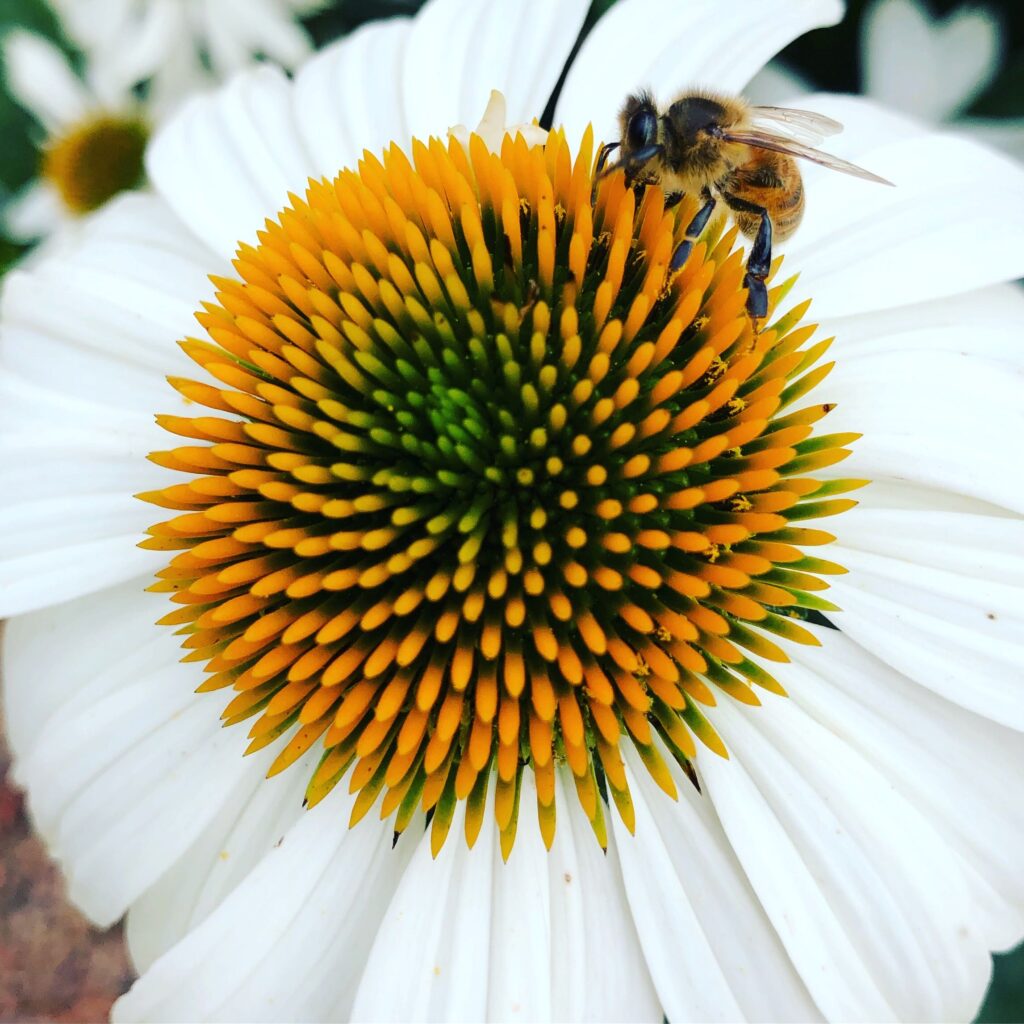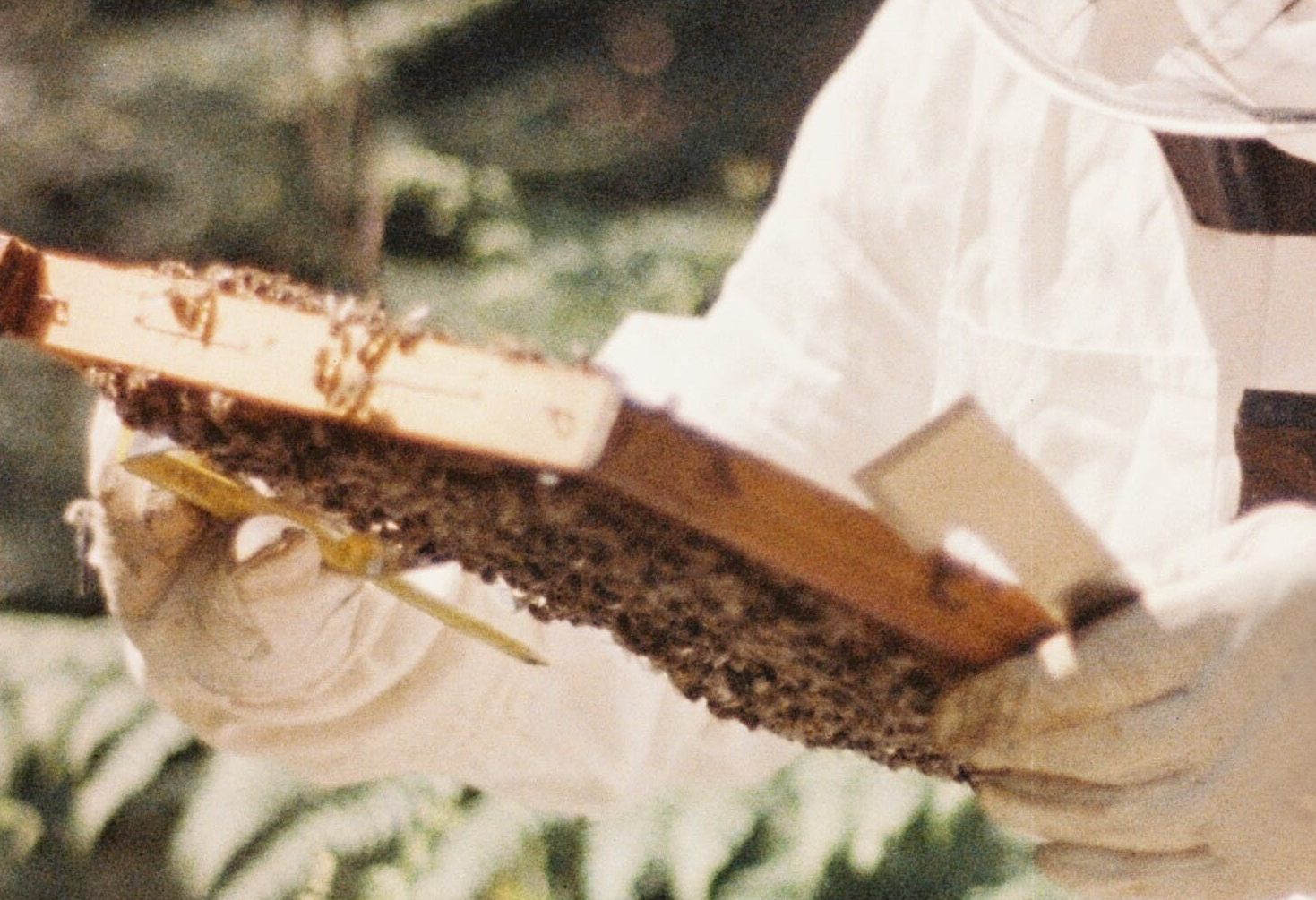
Beekeeping is different here
Keeping bees in the Mountain West requires location and climate-specific knowledge to support and protect healthy colonies particularly in our sometimes harsh, erratic climates and high elevations. Our CSU Extension training course offers unique, science-based educational information to prevent common pitfalls including weather-related issues, pests, diseases, and colony collapse.
We teach science-based beekeeping
What is Science-Based Beekeeping?
Science-based beekeeping focuses on maximizing honey production and pollination services through efficient, effective and integrated hive management. We support adherence to industry standards and practices that may involve some level of manipulation for optimal results. CSU utilizes unbiased, science- and research-based information and techniques, allowing the beekeeper to make informed decisions about their unique situations.
Hive Design & Management
Utilizing modern hive designs and management techniques, science-based beekeeping are based on research findings. This may include specific hive configurations, frame types, and spacing that have been proven to enhance bee health and productivity.
Feeding Practices
Supplemental feeding of bees with sugar syrup or other artificial food sources, especially during times of nectar scarcity, is considered a science-based beekeeping practice.
Approach to Medications & Treatments
Science-based beekeeping relies on scientific research and uses medications and treatments to manage pests and diseases effectively. It may involve the use of synthetic chemicals or pharmaceuticals to control issues when necessary. Chemicals must be properly applied to ensure there are minimal risks of residues in the honey and combs, or the development of pest resistance.
Use of Beekeeping Technology
Science-Based Beekeeping incorporates technology such as hive monitoring devices, sensors, and data analytics to track hive conditions. This data-driven approach can help beekeepers make informed decisions.
Practices and philosophies in beekeeping can evolve, and there are many nuances of beekeeping in the arid West, especially at elevation. We always recommend consulting the latest research and resources for the most up-to-date information.
Beekeeping Courses
New to beekeeping or new to the Mountain West? CSU Extension has a certifying full course ‘mastery bundle’ and multiple individual courses to meet anyone’s needs. Regardless of your path, you’ll receive in-depth beekeeping training provided by CSU faculty and specialists.
Full Course Program
$299 | Mastery bundle includes all 6 classes
Enroll Now | Click below for course details
AGLL 1051 – Understanding Bees
This course from CSU Extension takes you inside life in a bee colony, introducing you to their biology, anatomy, and social structures. This course is foundational for beekeeping in the Mountain West focused on the basics to get started. By the end of this course, you will:
- Recognize the attributes of various races of honey bees commonly available to beekeepers in Colorado.
- Identify developments and castes of honey bees.
- Discuss basic anatomy of honey bees and where important structures are located on the honey bee.
- Recognize honey bee stings, common treatments, and when to seek medical attention.
- Identify a variety of tasks accomplished both within the hive and outside of the hive by honey bees.
AGLL 1052 – Getting Started in Beekeeping
This course will serve as a guide, as you begin your journey to successful beekeeping in Colorado, our neighboring states, the mountain West, and beyond. Using science-based beekeeping principles and strategies, this course will cover how to:
- Classify and distinguish between various types of beehives, detailing their structural differences and appropriate applications in beekeeping.
- Analyze the essential components within a beehive, explaining their individual functions and interrelationships to support colony health and productivity.
- Evaluate and select suitable beekeeping equipment, based on its functionality, durability, and relevance to specific hive management tasks.
- Assess the process and considerations for purchasing bee packages, including evaluating suppliers, inspecting bee health, and ensuring compatibility with local conditions.
- Compare and contrast the characteristics, benefits, and challenges of nucleus colonies and established colonies, considering their respective roles in beekeeping operations and management strategies.
AGLL 1053 – Purchasing, Examining, & Maintaining a Hive
This course will lead you through bee acquisition, their necessary nutrients, monitoring and what to look for when inspecting your hives for overall health. By the end of this course, you will:
- Schedule and execute timely hive examinations, recognizing optimal times based on colony activity and seasonal beekeeping practices.
- Organize and assemble essential tools and materials, ensuring proper preparation and adherence to safety guidelines prior to conducting hive inspections.
- Initiate and manage a smoker effectively to maintain a calm environment during colony examinations, promoting a smoother inspection process and reduced bee agitation.
- Systematically inspect colony frames for indicators of health, disease, or pest infestations, interpreting findings to inform appropriate management interventions.
- Identify and locate the queen bee, larvae, and food stores within the hive.
AGLL 1054 – Plants, Pollination, & Habitat
In this course you will learn the optimal habitats and preferred plants, so that you may choose native and non-native plants that support your honeybees and other pollinators. At the end of this course you will:
- Explain what pollination is in seed-producing plants and why it is important.
- Describe the mutualistic relationship between plants and pollinators.
- Explain what a pollinator syndrome is and describe the characteristics of each syndrome.
- Choose native and non-native plants that support honey bees and other pollinators.
AGLL 1055 – Pathogen, Parasites, Diseases, & Pests
In this course you will learn how to identify and control various types of diseases, parasites, and pests for a healthy, happy hive. At the end of this course, you will:
- Identify and classify various bee diseases, including bacterial infections such as AFB and EFB, understanding their causes, symptoms, and implications for colony health.
- Recognize common pests affecting bee colonies, detailing how they infect the hive, modes of transmission, and management strategies to mitigate infestations.
- Examine the role and impact of varroa mites as parasitic pests in beekeeping, evaluating their effects on bee health, colony dynamics, and potential for secondary infections.
- Implement effective treatment protocols for varroa mite infestations, utilizing approved methods, tools, and best practices to safeguard colony health and productivity.
- Analyze the interplay between pathogens, parasites, diseases, and pests in beekeeping ecosystems, developing integrated management approaches to promote resilient and thriving bee colonies.
AGLL 1056 – Seasonal Management & Harvesting
In this course you will learn how to care for your hive year-round and how to reap the rewards of your healthy hive. Seasonal maintenance, harvesting honey, and how to use extractors will be covered. By the end of this course, you will be able to:
- Analyze the factors affecting bee winter survivability, devising strategies to maintain optimal colony health and population during the colder months.
- Monitor seasonal bee activity, interpreting behavioral changes and environmental cues to inform timely hive inspections and management decisions.
- Implement spring-to-early-summer hive maintenance practices, including inspections, cleaning regimes, and supplemental feeding, to support colony growth and productivity.
- Demonstrate proficiency in harvesting techniques, including frame collection and uncapping, ensuring the efficient extraction of honey while minimizing disruptions to the colony.
- Execute post-extraction processes, such as honey straining and bottling.
This bundle includes access to all 6 self-paced, online classes. There is no live instructor facilitation but you will have direct access to course instructors through email. Students receive access to the course for one year from the time of registration to complete all classes and earn a certificate. Noncredit courses do not produce academic credit nor appear on a Colorado State University transcript. Refunds will not be provided.
Individual Course Registration
$69 per course | Pick and choose as you go
- AGLL 1051 – Understanding Bees
- AGLL 1052 – Getting Started in Beekeeping
- AGLL 1053 – Purchasing, Examining, & Maintaining a Hive
- AGLL 1054 – Plants, Pollination, & Habitat
- AGLL 1055 – Pathogen, Parasites, Diseases, & Pests
- AGLL 1056 – Seasonal Management & Harvesting
Earning your Certificate
To obtain certification, trainees in the full course must complete all 6 online classes. Upon completion, you’ll earn an electronic CSU Beekeeping in the Mountain West certificate ready for you to print locally. To successfully complete this course, you must complete each course in the 6-part series, including the course assessment for each. Individual class certificates are not available.
Our Approach
An Integrated Hive Management (IHM) approach controls pests and disease by using strategies designed to be safe, effective and economical. IHM intervention strategies incorporate the following elements for management: cultural, mechanical, biological, and/or chemical controls. This approach requires continuous evaluation and planning steps so that adjustments can be made as necessary to increase success hive health.
Using IHM helps beekeepers to move from a series of often disconnected acts, to an organized system of pest management that is always in search of new ways to support healthy colonies while reducing the use of chemicals. When necessary, properly applied chemicals should ensure there are minimal risks of residues in the honey and combs, or the development of pest resistance. Beekeepers may adopt different IHM programs to customize their approach and achieve optimal results.
Adapted from Integrated Hive Management for Colorado Beekeepers by Dr. Arathi Seshadri, USDA Research Entomologist and retired CSU Extension specialist, Thia Walker
Publications
Integrated Hive Management for Colorado Beekeepers | CSU Guidebook
Feeding Honeybees in Colorado | CSU Extension Factsheet
Creating Pollinator Habitat | CSU Extension Factsheet
Questions? Reach out to csuext_programs@colostate.edu







